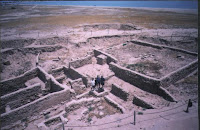
What is it? An informal, mixed group who all enjoy recreational cycling – whenever possible away from the traffic and the town. The rides are not ‘guided tours’ but we do try to find points of interest.
What do we do ?
We meet Friday mornings throughout the year and cycle as a group in many different areas of Kuwait. Rides are anything between 20 and 40 kms long depending on the terrain, and the group proceeds at the pace of the slowest rider. Members of the club take turns to plan and lead the rides. During the main season from October to June, we like to use desert tracks. Muttlah Ridge and the surroundings of Ahmadi and Sulaibiya are some of our favourite areas. We also ride on Failaka Island, in the Zour and Khiran areas and all along the coast, and we’ve enjoyed evening Iftar rides during Ramadan in Kuwait City. In the summer, rides are somewhat shorter and earlier in the morning, mostly in the shady suburbs. (Scroll down to view the photos).
We also have occasional social functions such as BBQs, parties, etc.. The group has been biking together since February 1999.
Who can join us ?
Anyone from teenage upwards is welcome to give it a try. If under the age of 18, we ask that you ride with us only under the personal responsibility of an adult rider. There is no application form, no membership fee and no committee. ‘Members’ are simply those who ride together regularly.
What do I need to join in ?
Mainly enthusiasm, some cycling experience and a bike suitable for off road riding. We strongly recommend wearing a well-fitting helmet. Gloves increase comfort and can prevent cuts if you do happen to come off. Colourful clothing makes you more visible to car drivers and to other riders when the group spreads out. You will also need a water bottle or two and a spare inner tube, and some basic bike tools will be useful.
Rides usually start around 06.00 to 08.00 and you need to allow several hours of your Friday morning, including travelling time, for each ride.
A degree of fitness helps since biking in the desert can be quite tough at times. We are not power bikers, but absolute beginners would not enjoy these rides.
Is it safe ?
All riding is entirely at your own risk. You are bound to fall off sometimes but we have had very few injuries over the years and nothing too serious. Common sense accident prevention and normal biking good practice are all we ask of you. Wearing a Cycle Helmet is the single best personal safety measure you can take. Drink plenty of water during the rides. Following the ride leader and not straying off the route or zooming out ahead of the group also enhances your safety. Bring a mobile phone and store numbers of other riders for use in the event of emergency. It is a club tradition that all riders are accounted for. If you are missing, we assume that you are lost, injured or have a problem with your bike. It is advisable to let the rest of the group know if you decide to separate from us so that we don’t have to organise a rescue mission.
Where is the next ride ?
We use email to inform members of the ride meeting place, start time and other useful information. Usually we put our bikes onto or into cars and drive to the ride start point. Getting to the start point is basically your own responsibility but regular riders can help.
Email Information:
Please send an email to Anthony Burrows, telling us something about yourself, your cycling experience and what bike you have;
anthonycburrows@gmail.com
Contact Details:
Tony’s what’s app number is: (9987 1279)
But since he is currently out of town; you could contact Khaled @ 99768515
Special Thanks to the dedicated members who made major contributions to the club:
Elena Resechova- started the club in 1999, led and ran it for 10 years.
Anthony Burrows: has been organizing rides for years.
John Lewington -aka Digital- discovered many routes.
Ian Smith/ Roy Holder- started Summer Season rides.
Dima Najm- made this blog in October 2006.














